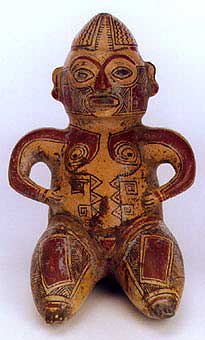Terracotta Seated Female Figure, 500 CE - 800 CE
Terracotta
11
PF.3869
During a phase of ceramic production known as Galo Polychrome, human figures were depicted with elaborate body painting. They are often very dramatic, as is the case with this handsome...
During a phase of ceramic production known as Galo Polychrome, human figures were depicted with elaborate body painting. They are often very dramatic, as is the case with this handsome sculpture, representing a seated female with legs outstretched and arms akimbo; a position most frequently seen in female effigies. The head is wide and tapers to a conical shape, which may be a form of hat or cranial deformation. The use of red and black is carefully chosen to accentuate certain areas, particularly the broad red lines on the eyebrows, nose, arms and large squares on the legs. This effect directs attention towards the eyes and middle portion of the abdomen. We see there a highly complex design with concentric circles around the breasts, flowing down into two opposing bands of horizontal triangles. The figure wears a tanga, pubic cover, and is otherwise naked. It is most likely this sculpture was intended as a fertility figure, probably owned by a member of the wealthy elite who could afford to commission an object requiring such talent and imagination to create.



